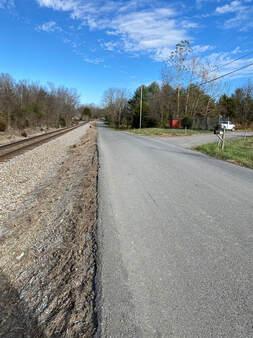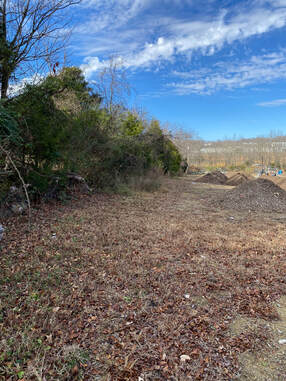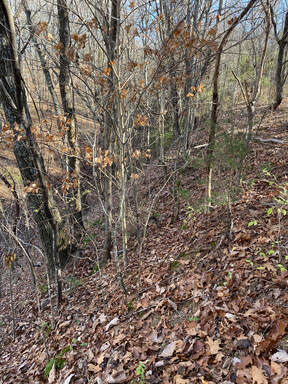|
Read below or click this link to download this guide for free.
|
| ||||||
Where to even start?!?
If you have no leads on a suitable property, try an online resource like this one.
Temporary or Permanent?
You may want to choose a temporary location to operate on for the first few years. In that time, you could work out the kinks in your operating procedures and develop a much better idea of what kind of property you’ll need to build a permanent compost facility that will grow from a small-scale pilot size to full commercial scale. I didn’t do that; I decided to take the plunge and purchase land.
Purchase or Lease or Exchange Services for Free Land Use?
I started out trying to do the last of these options. I met repeatedly with the officials of a nearby town. They said that they would let me use some unutilized land by a water intake facility. In exchange, I would process for free whatever SSO they brought me. In the end, they didn’t come through and it just wasted a bunch of my time. I realized that if I didn’t buy some land myself, my compost business wouldn’t get off the ground. I could have researched the possibility of a lease, but I didn’t like the impermanence and uncertainty of that option.
So I purchased the land that I built my facility on, and I’m glad that I did. I have the freedom to alter it as I see fit. I am building wealth in an appreciating asset as I make payments. Also, it happens to be an interesting piece of property that we’ve used for camping, celebrating the 4th of July, observing wildlife, and playing paintball. Best of all, I don’t have to worry about a landlord deciding that she or he is better off removing me in favor of some other tenant. Another benefit of owning the land is that it communicates a higher level of seriousness. I didn’t realize at the time that this would be the case. But as soon as I bought the property, government officials and other businesspeople stopped regarding my efforts as just another citizen’s wishful thinking. Their whole demeanor changed, and they took me more seriously.
On the other hand, I must admit that buying the property did tie up a great deal of credit that could otherwise have been used for machinery. But at the time I started, I had less of an idea of what machinery was truly useful, and truly a priority. If I spent the money on machinery instead of real estate, I may well have misspent it.
Regardless of whether you buy, lease, or co-locate, you must take these aspects of site selection very seriously.
So I purchased the land that I built my facility on, and I’m glad that I did. I have the freedom to alter it as I see fit. I am building wealth in an appreciating asset as I make payments. Also, it happens to be an interesting piece of property that we’ve used for camping, celebrating the 4th of July, observing wildlife, and playing paintball. Best of all, I don’t have to worry about a landlord deciding that she or he is better off removing me in favor of some other tenant. Another benefit of owning the land is that it communicates a higher level of seriousness. I didn’t realize at the time that this would be the case. But as soon as I bought the property, government officials and other businesspeople stopped regarding my efforts as just another citizen’s wishful thinking. Their whole demeanor changed, and they took me more seriously.
On the other hand, I must admit that buying the property did tie up a great deal of credit that could otherwise have been used for machinery. But at the time I started, I had less of an idea of what machinery was truly useful, and truly a priority. If I spent the money on machinery instead of real estate, I may well have misspent it.
Regardless of whether you buy, lease, or co-locate, you must take these aspects of site selection very seriously.
Waterways and DrainagE
When examining a prospective site, pay special attention to all waterways and drainage. In fact, you need to visit the site during and after heavy rains. Answer all of the following questions:
- Does water run onto my property from other properties? Will that water be contaminated with industrial chemicals, livestock manure, garbage, etc.? Does that run-on water quantity greatly increase with rainfall?
- Are there streams on the property or near it? Do those streams only run after rain events (“wet weather conveyances”)? Or are the almost always flowing (“blue line streams”)?
- Are there natural opportunities for rainwater collection?
- Where does water drain off of the property? Does it become an unmanageable torrent when it rains?
- Do parts of the property become a stagnant mess when it rains?
Neighbors and Zoning
If a property you’re considering is within a half mile of a suburban-style residential neighborhood, keep looking. Even if the zoning of the area doesn’t prohibit it, it’s not worth it. Regardless of how successful you think you’ll be at preventing odor and vermin, people are going to oppose your permit. Right or wrong, they’ll assume your facility will smell, and they’ll dread an increase in large trucks on the roads. The same goes for commercial areas like strip malls and office buildings.
You want a property that is either in an industrial or agricultural area and in one of those zoning classifications. If a landfill is nearby, so much the better.
You want a property that is either in an industrial or agricultural area and in one of those zoning classifications. If a landfill is nearby, so much the better.
Access quality and size of roads, corners, and railroad trackS
The previous section leads us to look for something in a rural area. However, that may not only give you a long commute, but it may also separate you from your waste disposal and compost product customers. In densely populated regions of the country, waste haulers are used to taking waste a long distance. Not so in less dense regions. While looking for properties, ask waste haulers (including municipal solid waste departments) how far they currently haul. Consider that your maximum radius.
Sooner or later, you’re going to want large vehicles to be able to get to your property. These will include not only 14ft trailers with equipment or brush, but also sanitation trucks with organics and semi trucks. How solid are the roads to your property? Do they flood or wash out in heavy rains? How wide are they? Can you get to your property without going through an S-curve or a railroad crossing hump? The road to my property has a tight S-curve on one end and a steep railroad hump on the other. It has been a pain. Be very sober about this part of the site selection. It is critical!
Enjoy a couple of images from a particular misadventure thanks to access challenges (and a well-meaning but inexperienced semi driver):
Sooner or later, you’re going to want large vehicles to be able to get to your property. These will include not only 14ft trailers with equipment or brush, but also sanitation trucks with organics and semi trucks. How solid are the roads to your property? Do they flood or wash out in heavy rains? How wide are they? Can you get to your property without going through an S-curve or a railroad crossing hump? The road to my property has a tight S-curve on one end and a steep railroad hump on the other. It has been a pain. Be very sober about this part of the site selection. It is critical!
Enjoy a couple of images from a particular misadventure thanks to access challenges (and a well-meaning but inexperienced semi driver):
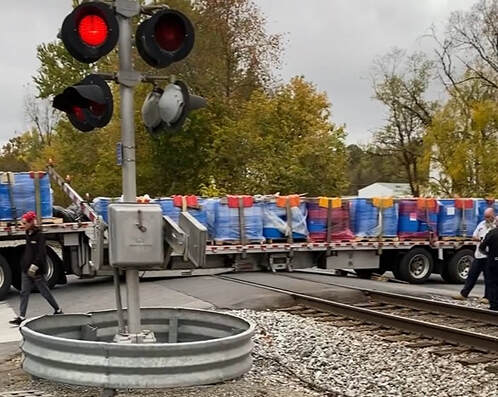
Here we see over 4500 gallons of beeswax hung up on the railroad. The truck’s wheels were spinning and couldn’t budge the rig forward or backward. Not to mention that this stretch of rail was shut down for hours.
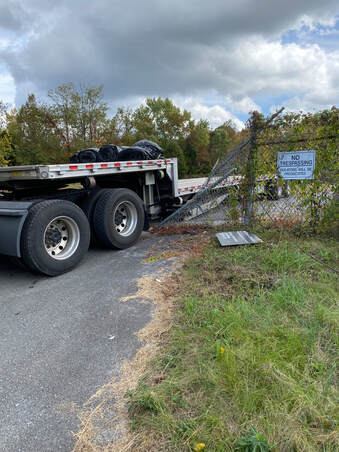
On the way out, he destroyed one side of my gate. Needless to say, I didn’t get any of the other millions of things I had lined up done that day. Join us in the worthy effort of composting and I guarantee you’ll have days like this. I still recommend it, but consider yourself warned!
|
This reminds me of another lesson to learn from my inexperience: avoid a narrow road that has a steep drop-off (or immovable structure like a lightpost or building) immediately on the opposite side of the road from your entrance, and for fifty feet in either direction. That also makes it hard for semis to get in and out. This is a pictures of the drop-off (due to a railroad track) that is opposite my gate.
|
Barriers to Entry
During the site selection process, pay attention to anything that may protect it. You don’t want random people to wander onto your site. Maybe they’ll get hurt; or maybe they’ll make or stash drugs. They might even steal or vandalize your equipment. (I got robbed … it sucks!!!) Your state regulations may well mandate natural or constructed barriers to entry.
Does the property already have usable fencing on it? Is the gate in good condition? Is it hard to go on to the property because of steep slopes and thick forests? I hope so. Luckily for me, my property has both:
Does the property already have usable fencing on it? Is the gate in good condition? Is it hard to go on to the property because of steep slopes and thick forests? I hope so. Luckily for me, my property has both:
Topography, Soil, and Geology
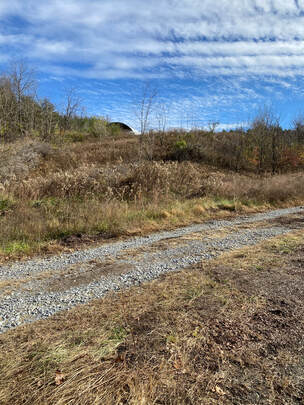
Steep slopes along the perimeter of the property may be great for discouraging trespassers, but you want as much of the middle of the property as possible to be nearly flat with a gentle grade. Grading and filling are expensive. For me, it was especially expensive because I was dealing with hard blue shale. The previous owner, General Shale, had stripped the property of all the soft shale decades ago. Breaking up that hard shale took a lot of time and money with a full-sized excavator outfitted with a breaker.
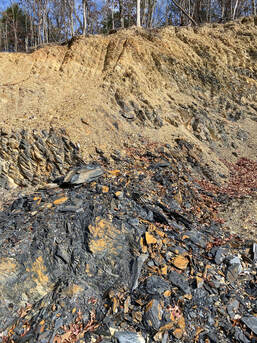
Maybe your property will have a deep layer of decent topsoil or soft shale. You’ll be able to shape that much better, and you can sell it, too. Always a good thing!
The grey material in this picture is hard shale, which we call “blue shale”. It’s useful, but so hard to break up that it isn’t economical as a product. It has been economical for some of my own surface-firming needs. The lighter yellow material above it is clay mixed with soft shale. If I had a lot more of that, I would absolutely make that part of my business.
Maybe your property will have a deep layer of decent topsoil or soft shale. You’ll be able to shape that much better, and you can sell it, too. Always a good thing!
The grey material in this picture is hard shale, which we call “blue shale”. It’s useful, but so hard to break up that it isn’t economical as a product. It has been economical for some of my own surface-firming needs. The lighter yellow material above it is clay mixed with soft shale. If I had a lot more of that, I would absolutely make that part of my business.
Extant Structures and Surfaces
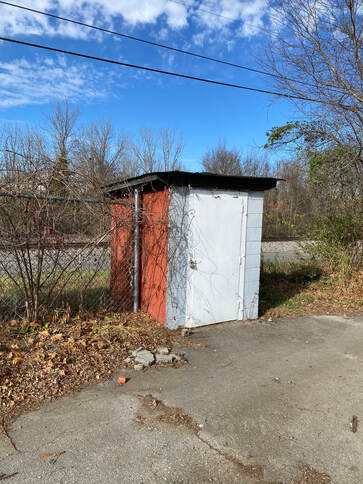
Examine the structures that are already on the property. Anything that is usable or salvageable is a big bonus. Anything that isn’t is a safety hazard and will cost you some time and money to pull down and remove. My property had an old, small cinderblock shed that was covered with poison ivy and inhabited by mice and snakes. It took a little time and effort to rehabilitate, but it’s been quite useful.
Extant asphalt pads, unless they’re totally broken up, are a big asset.
Usable Area
Once you’ve taken a thorough account of the property – by walking it, asking lots of questions, and examining the satellite imagery available online (especially handy are the linear and area measurement tools), you can sketch out the layout of your first stage of operation. Now you can really determine how much of the property will actually be usable for your compost business needs. By regulation, the most restricted area will be that used for the initial processing of organic waste.
The Final Site Selection Analysis and After the SalE
The site selection process for your compost business may be overwhelming. In the end, you’re not going to find the perfect property. You’ll have to decide for yourself what is most important, what you can fix, and what you can live with. Be sure to bring up the shortcomings when you’re negotiating with the current owners on price. The seller may not see an inconvenient stream as a problem, but it is to you. If it lessens the property’s utility for you, that should be reflected in the price.
As long as you don’t rush it, you’ll probably feel a good bit of relief and excitement once you get a property. It will really help you focus your planning. As soon as possible, get down to the work of preparing the site for processing!
As long as you don’t rush it, you’ll probably feel a good bit of relief and excitement once you get a property. It will really help you focus your planning. As soon as possible, get down to the work of preparing the site for processing!
